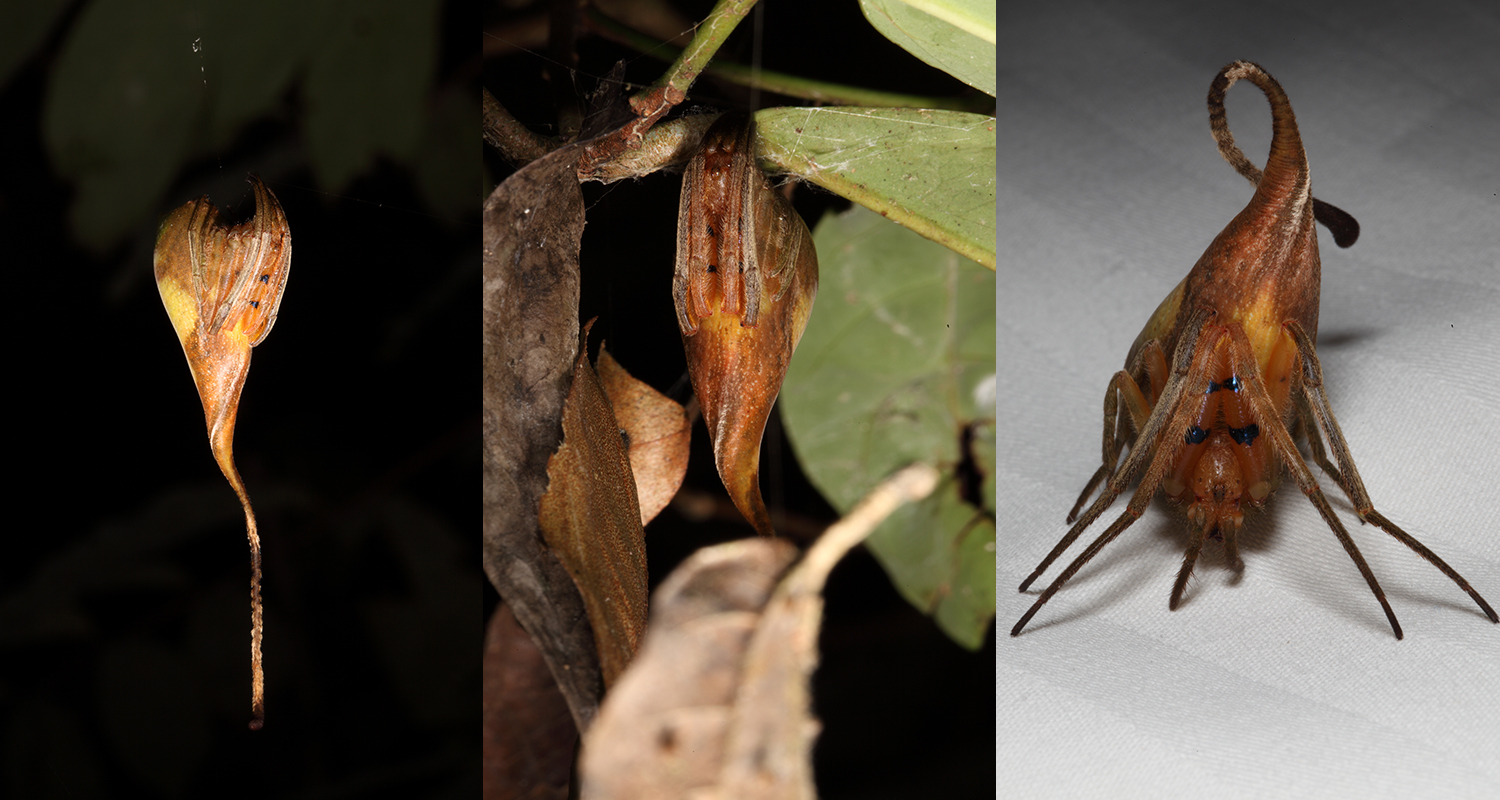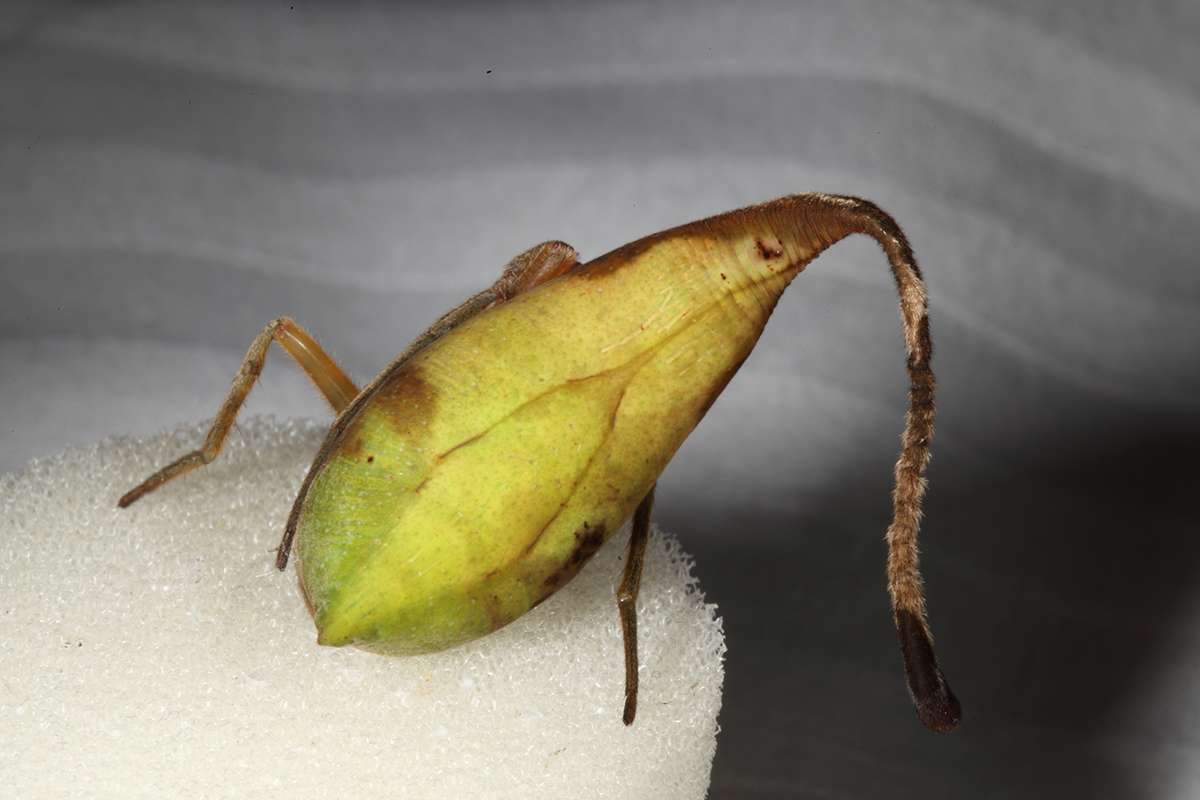Newfound Spider Species Masquerades As a Dried-Up Leaf

In the animal kingdom, sometimes the best survival strategy is to pretend to be something you're not — either to ambush unsuspecting prey or to convince predators that you're not very tasty.
And scientists recently discovered a spider that uses a unique masquerade to hide in plain sight. It is the only known spider to have a body that bears an uncanny resemblance to a dangling, partly dried-up leaf.
The find was reported in a new study, though the spider is yet to be described and assigned a species name.
The newfound costumed arachnid is in the Poltys genus in the orb spider family, which contains more than 3,000 species and one spider celebrity from children's fiction — a Araneus cavaticus was the barn spider Charlotte from the classic story "Charlotte's Web" (Harper and Brothers, 1952). [In Photos: 13 Animals That Mimic Plants]
A leggy masquerade ball?
Masquerading is far more common in insects than in arachnids. In fact, many types of insects have bodies that mimic plants. For example, the Phasmatodea order contains hundreds of species of so-called stick insects, which look like bare branches or leaves. And brightly colored orchid mantises have petal-shaped legs to complete their disguises as harmless flowers, tricking other insects into flying close enough for the mantises to snatch them out of the air.
But about 100 spider species also sport physical features that make them appear inanimate and unappetizing, like a jumble of twigs, plant debris or a messy glob of bird poo.
This is the first known spider species to be leaf-shaped. And its discovery was accidental, according to the study's lead author, Matjaz Kuntner, a principal investigator with the Evolutionary Zoology Lab at the Biological Institute Jovan Hadzi, Scientific Research Centre of the Slovenian Academy of Sciences and Arts.
Get the world’s most fascinating discoveries delivered straight to your inbox.
Make like a leaf
The scientists spied and photographed the unusual arachnid in 2011, while looking for other types of spiders in Yunnan, China. They found the individual — a female — on a twig, surrounded by dead leaves and with no web nearby. The researchers noted that her back looked like a living, green leaf, while the underside of her body was brown, mimicking a dead leaf, and a hairy, stalk-like structure protruded from her abdomen.

Leaves close by the female spider on the branch were attached with silk, which hinted that she had placed them there deliberately to further camouflage herself. However, additional observations would be necessary to confirm this behavior, Kuntner told Live Science.
After searching for two weeks, Kuntner and colleagues were able to find only one more leaf-shaped spider — a juvenile male, crouching on a web. Next, they turned to museums to see if they could turn up more specimens, Kuntner said.
"Having first noticed their rarity in nature, we talked to curators and established their overall rarity," he said. One similar specimen eventually emerged from a museum collection — a female that had been found in Vietnam. But the scientists suspected the Vietnam spider belonged to a known species in the Poltys genus, whereas the other two spiders likely represented a new species.
There is still much to be learned about this enigmatic leaf imitator — and considering how difficult it was to find just the first two representatives, that's easier said than done. The authors concluded their study with the somewhat rueful observation that the mysterious spider's secretive habits and nocturnal lifestyle enabled it to successfully avoid not only predators, but researchers as well.
The findings were published online Nov. 11 in the Journal of Arachnology.
Original article on Live Science.

Mindy Weisberger is an editor at Scholastic and a former Live Science channel editor and senior writer. She has reported on general science, covering climate change, paleontology, biology and space. Mindy studied film at Columbia University; prior to Live Science she produced, wrote and directed media for the American Museum of Natural History in New York City. Her videos about dinosaurs, astrophysics, biodiversity and evolution appear in museums and science centers worldwide, earning awards such as the CINE Golden Eagle and the Communicator Award of Excellence. Her writing has also appeared in Scientific American, The Washington Post and How It Works. She is the author of the book "Rise of the Zombie Bugs: The Surprising Science of Parasitic Mind Control," published by Hopkins Press.
